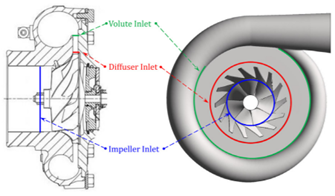Select Your Country/Region
Current Region:
 Global (EN)
Global (EN)
Choose a different country or region to see the content specific to your location
- Technologies
- Working Principle of Turbo Blowers
Current Region:
 Global (EN)
Global (EN)
Choose a different country or region to see the content specific to your location
How can we help you?
The single stage high-speed turbo blower follows the compression principle of the centrifugal compressor, or dynamic compressor with radial design.
It works at constant pressure with performance depending on external ambient conditions delivering compressed air without pulsations. This is different from the positive displacement compressors working at constant flow, where the inlet air density does not affect performance and the compression is pulsating.
Air is drawn axially into the center of the impeller with radial blades and is pushed radially by means of centrifugal force. The rotation of the impeller accelerates the speed of air (kinetic energy), and forces it to pass through the downstream diffusers and volute.
Here, the high kinetic energy is converted into potential energy (pressure) slowing down the speed of the air through expansion. The velocity energy is converted into pressure energy according to Bernoulli’s principle (pressure is inversely proportional to velocity squared).

At Robuschi, we have been providing products and services for the low pressure compressed air market for decades. We have supplied generations of customers worldwide with our innovative blower solutions. Our latest innovation comes in the form of a blower boosted by turbo technology.
Now, you have access to a full spectrum of low pressure technologies, including lobe, screw and now turbo blowers.
The Robuschi Robox Turbo is equipped with a centrifugal high speed turbo blower.
Designed to be compact and efficient, but also provide increased and more reliable performance due to its capability to overclock the turbo to provide more air pressure when needed.
The efficiency of turbo blowers can tackle energy concerns in wastewater treatment plants, and at the same time decrease their environmental and financial impacts (total cost of ownership).